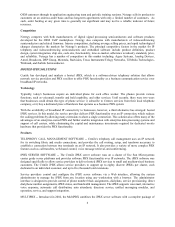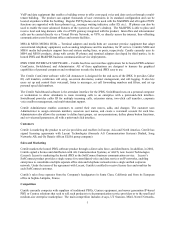8x8 2003 Annual Report Download - page 17
Download and view the complete annual report
Please find page 17 of the 2003 8x8 annual report below. You can navigate through the pages in the report by either clicking on the pages listed below, or by using the keyword search tool below to find specific information within the annual report.14
fee and recognize revenue at the time collection becomes reasonably assured, which is generally upon receipt of
payment.
For arrangements with multiple obligations (for example, undelivered maintenance and support), we allocate
revenue to each component of the arrangement using the residual value method based on the fair value of the
undelivered elements, which is specific to the Company. This means that we defer revenue from the arranged fee
that is equivalent to the fair value of the undelivered elements. Fair values for the ongoing maintenance and support
obligations for our technology licenses are based upon separate sales of renewals to other customers or upon renewal
rates quoted in the contracts. We base the fair value of services, such as training or consulting, on separate sales of
these services to other customers. We recognize revenue for maintenance services ratably over the contract term.
Our training and consulting services are billed based on hourly rates and we generally recognize revenue as these
services are performed.
For sales generated from long-term contracts, we use the percentage of completion method of accounting. In doing
so, management makes important judgments in costs and in measuring progress towards completion. These
judgments underlie our determinations regarding overall contract value, contract profitability and timing of revenue
recognition. Revenue and cost estimates are revised quarterly based on changes in circumstances, and any losses on
contracts are recognized immediately.
If an arrangement includes acceptance criteria, revenue is not recognized until we can objectively demonstrate that
the software or service can meet the acceptance criteria or when the customer has signed formal acceptance
documentation. If a software license arrangement obligates us to deliver unspecified future products, revenue is
recognized on a subscription basis, ratably over the term of the contract.
For all sales, except those completed via the internet, we use either a binding purchase order or other signed
agreement as evidence of an arrangement. For sales over the internet, we use a credit card authorization as evidence
of an arrangement.
Our ability to enter into revenue generating transactions and recognize revenue in the future is subject to a number
of business and economic risks discussed below under "Factors that May Affect Future Results."
Collectibility of accounts receivable
We must make estimates of the collectibility of our accounts receivable. Management specifically analyzes accounts
receivable, including historical bad debts, customer concentrations, customer creditworthiness, current economic
trends and changes in our customer payment terms when evaluating the adequacy of the allowance for doubtful
accounts. The accounts receivable balance was $1.4 million, net of an allowance for doubtful accounts of $141,000
as of March 31, 2003, and one customer represented 30% of our gross accounts receivable. Based upon this
customer's past payment history, discussions with the customer and our review of their financial condition, the
outstanding balance was considered collectible and therefore no portion of this balance was specifically reserved for
at March 31, 2003.
Valuation of inventories
We write down our inventory for estimated obsolescence or unmarketable inventory equal to the difference between
the cost of inventory and the estimated market value based upon assumptions about future demand and market
conditions. If actual future demand or market conditions are less favorable than those projected by us, additional
inventory write-downs may be required.
Valuation of goodwill
We assess the impairment of goodwill whenever events or changes in circumstances indicate that the carrying value
may not be recoverable. Factors we consider important that could trigger an impairment review include the
following:
• significant underperformance relative to projected future operating results;
• significant changes in the manner of our use of the acquired assets or the strategy for our overall business;
























